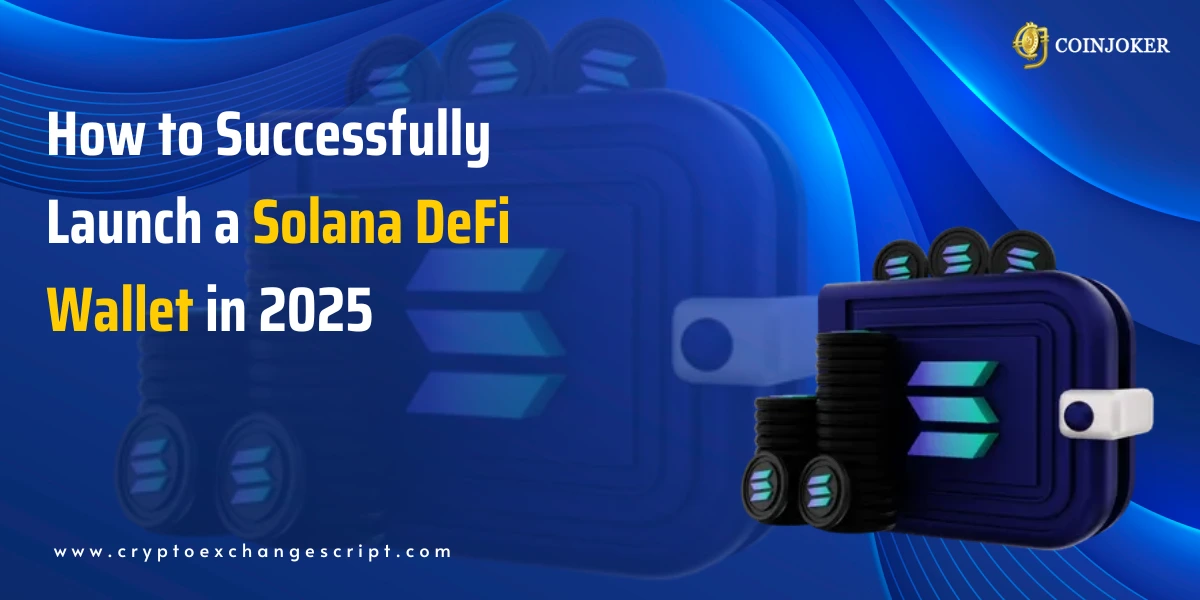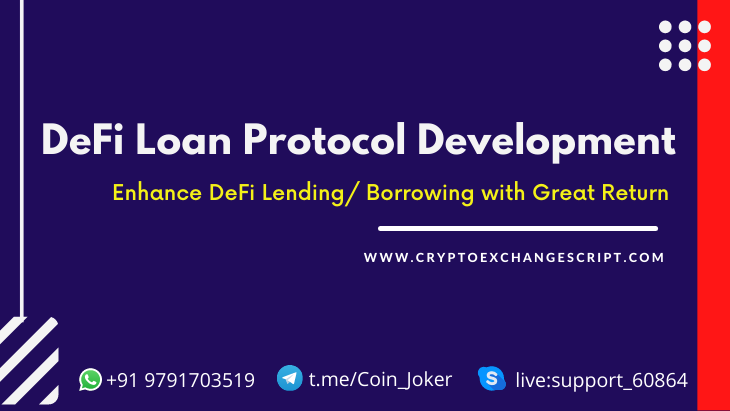In earlier stage, the lend | borrow features are a part of a DeFi ecosystem. But recently they have derived a protocol for LOAN feature that performs Lend | Borrow functionality uniquely.
Loan Protocol Development
Loan Protocol Development of DeFi Loan [Lending | Borrowing] working by Smart contract with front end functionality and UI/UX based on client preference.
Possible Networks of Loan Protocol Development
1. Ethereum
2. TRON
3. Binance Smart Chain
4. Matic
Loan Protocol - A Overview
Crypto assets sitting in a wallet don’t accrue interest. The underlying value may increase or decrease, but you're not earning anything for holding that particular cryptocurrency. This is where DeFi loans come in.
Imagine being able to lend your crypto to someone else and earn interest on the loan. That's how banks currently work, but it's a service that few individuals can access. In the world of DeFi, anyone can become a lender.
By loaning your crypto assets to others, you’re able to generate interest on those assets. There are a wide variety of ways to do this, but the main way is through lending pools. These are essentially the loan offices of a traditional bank.
Smart Contract and Loans
Using a smart contract, found on projects like ethereum allows users to pool their assets and distribute those assets to borrowers with the rules of the loan written into the contract.
These loan pools have their own way of distributing interest to each investor, so it’s worth taking some time to research the type of pool you’d like to be involved in as an investor. This same advice goes for borrowers as each pool will take a different approach on how to borrow from their assets and the rules for borrowing.
When a borrower goes to get a loan at a bank, they would need collateral for that loan. If you get a car loan, the car itself is the collateral. If you stop paying on the loan, the bank will take your car. That makes sense, right? But given that a decentralized system is
A) anonymous and
B) doesn’t have physical property that can be used as collateral, another system needs to be in place.
How loan protocol works for DeFi lending?
When a borrower wants to take out a loan, they have to offer something more valuable than the amount of the loan. That means they need to deposit via a smart contract an amount of currency that is at least of equal value to the amount they'd like to take out. The collateral can be in a wide variety of currencies however. So if you want to borrow one bitcoin, you’d need to deposit the current price for one bitcoin in DAI, for example. Or 11,296 DAI.
A few months later, you’re finished with the loan and need to pay back your bitcoin + 10 percent and then you receive your 11,296 DAI back. The borrower is happy because they received their original DAI back without having to sell them and the pool is happy because they can now distribute the 10 percent in bitcoin across the pool of investors.
Steps by Step process of Defi Lend/Deposit Works?
- Connect one of the available supported wallets (Metamask | Coinbase | Ledger etc,.)
- Deposit any one of the supported cryptos to add liquidity to the pool
- From this liquidity pool, the borrowers can get loans
- As soon as the lenders deposited crypto assets to the pool, they will receive XXtokens (aTokens in AAVE)as the proof of their deposit
- This pegged at a ratio of 1:1. So for example, if you deposit 100 DAI, you get 100 XDAI
How Borrow Works?
- Before borrowing users need to deposit any asset to be used as collateral
- Select the crypto asset the user wish to borrow
- Set the amount user need based on your available deposits that would be used as a collateral for the loan
- Select either stable or variable rate and confirm transaction
- The maximum amount a user can borrow depends on the value the user has deposited and the available liquidity. For example, the user can’t borrow an asset if there is not enough liquidity or if their health factor doesn’t allow them to
Stable Rate
Stable rates act as a fixed rate in the short-term, but can be re-balanced in the long-term in response to changes in market conditions
Variable Rate
Variable rates are more volatile than stable rates
Liquidation
A liquidation is a process that occurs when a borrower's health factor goes below 1 due to their collateral value not properly covering their loan/debt value. This might happen when the collateral decreases in value or the borrowed debt increases in value against each other
Example 1
Bob deposits 10 ETH and borrows 5 ETH worth of DAI.
If Bob’s Health Factor drops below 1 his loan will be eligible for liquidation.
A liquidator can repay up to 50% of a single borrowed amount = 2.5 ETH worth of DAI.
In return, the liquidator can claim a single collateral which is ETH (5% bonus). The liquidator claims 2.5 + 0.125 ETH for repaying 2.5 ETH worth of DAI.
Example 2
Bob deposits 5 ETH and 4 ETH worth of YFI, and borrows 5 ETH worth of DAI If Bob’s Health Factor drops below 1 his loan will be eligible for liquidation.
A liquidator can repay up to 50% of a single borrowed amount = 2.5 ETH worth of DAI.
In return, the liquidator can claim a single collateral, as the liquidation bonus is higher for YFI (15%) than ETH (5%) the liquidator chooses to claim YFI.
The liquidator claims 2.5 + 0.375 ETH worth of YFI for repaying 2.5 ETH worth of DAI.
How to Repay Using Loan Protocol?
In order to repay with your assets you just need to go to the Dashboard and follow these steps:
-Click on repay on the debt you want to repay.
-Choose repay "With your current collateral"
-Select the asset you want to repay and the amount on the left side (Borrowed Asset).
-Select the asset you want to use to repay to in the right side (Select Collateral)
-Make sure to check the swap rate and check the slippage. You can edit it based on your preferences. Depending on the slippage, the expected might differ and the transaction might even fail if you set it too low. After this click on Continue.
-In the next step you need to send the approval and submit the transaction. The approval transaction will only be required the 1st time you do this step, unless you revoke the approval.
-Make sure to have enough ETH for the transaction cost. After sending both transactions your repayment will be done.
Admin's Revenue Model
- Lending & Borrowing Fee
- Proposal Fee
- Staking Pool Fee
How DeFi Loan Protocol helps the financial services sector?
1. Lending/Borrowing
2. Tokenization
3. Decentralized Exchanges
4. Insurance
5. Asset Management
6. Savings
7. Stable Coins
Use Case of DeFi Loan Protocol Development
- Single platform for crypto asset lending
- Non-taxable liquidity
- Arbitrage Trading
- Margin trading
- Flash loans
Where to Initiate Defi Loan protocol Development?
Coinjoker - A Leadin DeFi Development company builds a high reliable and scalable loan protocol development using DApps, Smart contracts, among other DeFi protocols.
We are early adopters of Defi Development solutions and having 100+ clients all over the world.
Blockchain Development : Bitcoin, Ethereum, Hyperledger, Corda, and more.
Mobile App Development : Android Native, iOS Native, React Native, Flutter, Xamarin.
UI/UX Design : Strategy, Planning, UI/UX Design, Wireframing, Visual Designs.
Web App Development : Node.JS, Angular, React.JS, PHP.
Backend Development : MongoDB, MySQL, AWS, Firebase.
Get A Free Quote of DeFi Loan Protocol Development
Trending Blogs

AI
AIOps: Revolutionizing IT Operations with Artificial Intelligence
In today's digital age, businesses are increasingly reliant on IT infrastructure to ensure seamless ...

AI
Quantum Computing: The Future of High-Performance Computing
Quantum computing is no longer just a futuristic concept—it’s becoming a real force of change in ...

Cryptocurrency Exchange
Mastering Crypto Trading Strategies: A Guide for Traders
Cryptocurrency trading has revolutionized financial markets, offering traders lucrative opportunitie ...

AR/VR
Virtual Reality and AI in Healthcare: The Next Big Leap in Medical Consultations
Explore how Virtual Reality and AI are transforming healthcare, revolutionizing medical consultation ...

Cryptocurrency Exchange
Coinmooner Clone Script: Simplify Crypto Discovery & Boost User Engagement
The cryptocurrency market is expanding rapidly, with thousands of new projects launching every year. ...

Blockchain
Blockchain-Based Streaming: Instant Content Monetization
The digital content industry has also experienced a sweeping revolution over time, with content bein ...
AR/VR
AI Avatars in VR: Crafting Digital Souls for Virtual Worlds
In today’s virtual-first world, the lines between fact and digital experiences continue to blur. O ...

AR/VR
AI-Powered VR Classrooms: The Future of Learning
In the fast-evolving world of education, generation is reshaping how we teach and study. Among the m ...

Cryptocurrency Exchange
Toobit Clone Script: A Ready-Made Solution to Start Your Crypto Exchange
The cryptocurrency market has been on an incredible run lately, growing at a pace that’s tough to ...

Cryptocurrency Tokens
How to Successfully Launch a Solana DeFi Wallet in 2025
The DeFi (Decentralized Finance) industry is evolving rapidly, providing permissionless and decentra ...

